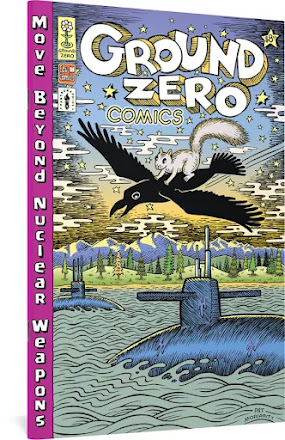Sometimes true historical
stories seem so outrageous that they can feel like a fictional script. When visuals
such as comic art are added, the stories become even more engaging. Madame
Choi and the Monsters is one of those stories -- so engaging that it seems
that it must be fake. Here is the book’s advertising blurb:
The
incredible-yet-true story of celebrated South Korean actress Choi Eun-hee,
abducted in 1978 by North Korean secret agents on the orders of their
film-crazed future leader Kim Jong-il. Six months later, filmmaker Shin
Sang-ok, Choi Eun-hee’s ex-husband, is abducted in turn. Choi and Shin remain
unaware of each other’s fates until they meet again at a dinner hosted by Kim
Jong-il in 1983. Kim forces Choi and Shin to make films, including the infamous
kaiju cult classic Pulgasari (1985), all while convincing the world that they
serve North Korea willingly. Choi and Shin’s love rekindles slowly in this
reunited captivity. Only at the 1986 Vienna Film Festival do they escape,
fleeing in a daring car chase to the American embassy.
The script of Madame Choi
was written by Patrick Spät. He took the approach of weaving in the script of Pulgasari,
as well as biographies of Choi and Shin, as an effective way to give readers
exposure to each creator as well as their most famous movie. Some additional
liberties were taken with the storyline, particularly the spirit within the Pulgasari
arc that allows for a conscience and narrator device. Both Spät and Domingo are
based in Berlin, and this book is translated from German.
Spät’s script also allows readers to understand the other quirks within the North Korea (DPRK) regime of the 1970s. Kim Jong-il was so obsessed with movies that he had amassed a reported 20,000 film library, and the first part of the graphic novel shows that obsession as Kim sent infiltrators into the South to steal movies and bring them back. Eventually, Kim decides to take the next logical step of making his own films, but with South Korean (ROK) creators.
While Choi Eun-hee was well
known as an actress, she was also from a conservative country. Soouth Korea had
traditional expectations for people, and when Choi divorced her abusive first
husband, she felt repercussions. She met Shin, a director, and they fell in
love and married. While unable to have their own children (another stigma in
South Korea) they adopted two children and continued to produced films that
were both popular as well as critically acclaimed. They produced 60 films
throughout the 1960s and 1970s. (48) However, the South Korea of the 1970s was
a military dictatorship, and not the free democracy of today. They fell afoul
of government censors, and this led to strain on the two, both professionally
and personally. (63) This constant tension of creativity and morals is one that
now seems oxymoronic compared to North Korea and its repression, and while the
censored events in the films may seem quaint by today’s standards, within South
Korea at that time they were serious.
Purportedly, the strain
in the marriage from censorship caused Shin to engage in an affair with another
actress. This is critical to the story as it set in motion their divorce, their
problems with each other’s careers, and the lure by which Kim brought the two
at different times to Hong Kong, when they were then kidnapped and brought to
the DPRK to make films for him. They re-met in North Korea in October 1983. (127-129)
As Shin noted, he had the ability to do things like blow up an actual train on
film (140-141), but at the same time, he suffered far more degradation than
Choi did, although both were held in North Korea for years.
The story of Pulgasari is a folk legend in Korea, and the film is a monster movie made with both Japan and China. The film itself also had themes of the corruption of power, the need of a supreme (and ultimately ineffective) weapon to defeat monsters, and the idea that enemy forces would be defeated on the strength of traditional values. In the end, it was this movie, made with some of the crew who worked on the Toho Studio-era Godzilla films, that served as the basis for their escape. The film was sent to the Vienna film festival, and Choi and Shin carefully planned their escape from the hotel where they were staying. After a high-speed chase through the streets, the two ended up at the US Embassy.
While the graphic novel
ends with the destruction of Pulgasari, and the real-world result of the guards
being shot for allowing Shin and Choi to escape, there is a timeline which
gives the further movements of the film-making family, from their reuniting
with their adopted children in Virginia, their time in Hollywood, and their
eventual return to South Korea, which was also a time of clarifying the stories
about their time in the North. Both have since passed away, without gaining any
residual rights or money from Pulgasari, which is now considered a cult
classic.
In all, the book is a
quick overview of geopolitics and monster movie making, that also gives insight
into a closed society, one that is led by dictators obsessed with the very
culture they deride. It gives one pause to think about what other stories might
be out there to tell.


































